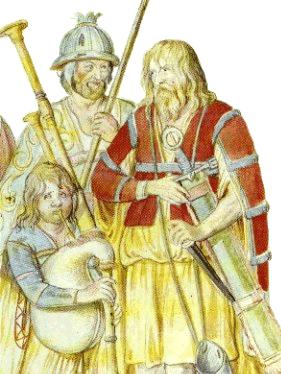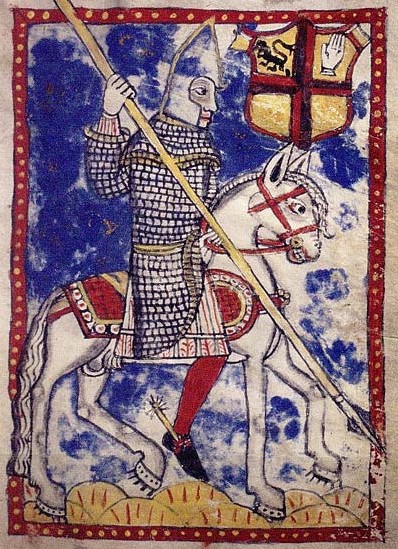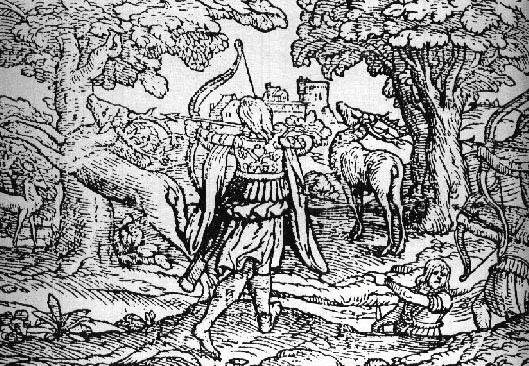
Can anyone tell me anything about the helmet worn in this picture? All I know is these are 16th century Irish warriors as depicted by Lucas De Heere. Has anyone seen anything similiar?
 Attachment: 28.01 KB
Attachment: 28.01 KB


Aside from the weird crest, the helmet looks pretty much like a pikeman's pot.
Looks like an attempt to depict a distinctive Irish helmet that appears to consist of quilted fabric or leather reinforced by an iron frame. See them on the Irish horsemen at right in this image:
http://www.lib.ed.ac.uk/about/bgallery/Galler...61_jpg.jpg
And possibly on the chieftain here:
http://www.lib.ed.ac.uk/about/bgallery/Galler...53_jpg.jpg
http://www.lib.ed.ac.uk/about/bgallery/Galler...61_jpg.jpg
And possibly on the chieftain here:
http://www.lib.ed.ac.uk/about/bgallery/Galler...53_jpg.jpg
I am familiar with the helmets you depicted but this one definetly looks all steel. And I know there has been some debate to the ones you depict as be steel also maybe with some kind of pattern in the metal. There is a written source that says in 1396 the Irish wore round iron helmets like the moors and saracens. I never unerstood why thy would digress to a leather model in the 16th century. Do you have info or sources?
| Kevin P Molloy wrote: |
| Do you have info or sources? |
Here's what Merv Cannon wrote in another thread:
"Been chatting recently with our irish friends at ..... http://livinghistory.ie/modules.php?name=Forums&file=index
about the same sort of thing. this time its the distinctive and unusual Irish "Cathbarr" or helm some of which were solid and some were padded in the 'spangens' .... dont know whether leather was used, but it is assumed so with woll padding underneath and quilted. Still. very interresting though. As usual, any info on Irish gear is harder than finding a Leprechaun .....( thank goodness for Niall Murays site ! )"
There may be something in my Irish materials, but I'm not sure. I don't know of any reference that mentions the material or construction of the helmets. My iron/fabric/leather suggestion is mere speculation, but I vaguely recall some European helmets of interwoven iron strips and some of iron frame construction over leather, like the Cathbarr Merv mentioned.
As for why they would use leather after the innovation of plate armour--There are plenty of examples of folks who had a choice preferring fabric or leather over plate armour. There is evidence of English colonists in America chopping up plate to make brigandines or simply using fabric armour of the same construction their ancestors wore 150 years earlier. Buff coats were considered armour, so it wouldn't necessarily be a regression to use padded buff leather under a steel or iron frame. What did the Irish face at home? Axes, swords, light bows and javelins, daggers. Fabric or leather armour reinforced by metal might be sufficient, and certainly cheaper and much lighter.
Richard Fay introduced this bit of information:
"I've found a reference to English archers at Agincourt wearing leather helmets. It's from Agincourt by Christopher Hibbert. It's a "popular history" account of the battle, first published in 1964, but this excerpt is still interesting:
Christopher Hibbert wrote:
A few archers, usually those who were mounted, had chain hauberks and the black cloth jackets of others were lined with mail, but for the most part those who took part in the 1415 expedition were without metal armour. They were for the most part, it seems, without the steel or chain skull cap worn on previous campaigns and wore instead conical hats made of boiled leather or tarpaulin-covered wickerwork strengthened inside with strips of iron, though these, apparently, were far from universal.
I've heard of basket-cases, but wickerwork helmets? It sounds like wearing a basket on your head! Has anyone else heard of this from other sources? It's a bit off-topic from "leather helmets", but I'm interested to hear of any other instances of "wickerwork" helmets being worn in medieval Europe! (I have seen steel or iron helmets or hat liners made of strips like an open-work basket!)
The construction described here sounds like a good match for what we see in the images in question.
_________________
"I've found a reference to English archers at Agincourt wearing leather helmets. It's from Agincourt by Christopher Hibbert. It's a "popular history" account of the battle, first published in 1964, but this excerpt is still interesting:
Christopher Hibbert wrote:
A few archers, usually those who were mounted, had chain hauberks and the black cloth jackets of others were lined with mail, but for the most part those who took part in the 1415 expedition were without metal armour. They were for the most part, it seems, without the steel or chain skull cap worn on previous campaigns and wore instead conical hats made of boiled leather or tarpaulin-covered wickerwork strengthened inside with strips of iron, though these, apparently, were far from universal.
I've heard of basket-cases, but wickerwork helmets? It sounds like wearing a basket on your head! Has anyone else heard of this from other sources? It's a bit off-topic from "leather helmets", but I'm interested to hear of any other instances of "wickerwork" helmets being worn in medieval Europe! (I have seen steel or iron helmets or hat liners made of strips like an open-work basket!)
The construction described here sounds like a good match for what we see in the images in question.
_________________
Can anyone tell me were I can find a bascinet similiar to the one depicted in this picture or were I can have one made?
 Attachment: 120.79 KB
Attachment: 120.79 KB


Do you have a source for the pic ? Time and place it was drawn/painted might help us guess what the helm is exactly ?
Could be a bascinet but the rest of the armour looks earlier than when the bascinet became popular.
Could be a conical spangelhelm with cheek pieces or extended down to lower neck level.
It also resembles a barbute for the face opening ?
Makes me think that there might have been a lot of variations in helm styles that we have no knowledge of as this is the first time I have seen this artwork and this exact type of helm: It just seems to have elements of a lot of later helms ?
( Edited, additional: Re-reading the " Topic " title, I now assume that this is Irish art and Irish armour which may have been locally still very much like 11th or 12th century armour even into the 14th 15th and even early 16th century. So, maybe a spangenhelm influenced by bascinet and barbute designs ??? ).
Could be a bascinet but the rest of the armour looks earlier than when the bascinet became popular.
Could be a conical spangelhelm with cheek pieces or extended down to lower neck level.
It also resembles a barbute for the face opening ?
Makes me think that there might have been a lot of variations in helm styles that we have no knowledge of as this is the first time I have seen this artwork and this exact type of helm: It just seems to have elements of a lot of later helms ?
( Edited, additional: Re-reading the " Topic " title, I now assume that this is Irish art and Irish armour which may have been locally still very much like 11th or 12th century armour even into the 14th 15th and even early 16th century. So, maybe a spangenhelm influenced by bascinet and barbute designs ??? ).
Sean,
You have to be careful with his Agincourt archer helmet. The same is done with some at crecy because in Edward's register it mentions leather helmets for some of his archers. The problem is people speculate as to what type of leather helmets they were without any hard evidence to base them off of. I have seen reference to leather helmets around agincourt not sure if its the same and it does not mention wicker anything. Does he have a footnote? Might be time to backtrack it and verify he is accurate.
It could be banded steel like some of the vendel helmets are. Would be an odd but interesting if so.
RPM
You have to be careful with his Agincourt archer helmet. The same is done with some at crecy because in Edward's register it mentions leather helmets for some of his archers. The problem is people speculate as to what type of leather helmets they were without any hard evidence to base them off of. I have seen reference to leather helmets around agincourt not sure if its the same and it does not mention wicker anything. Does he have a footnote? Might be time to backtrack it and verify he is accurate.
It could be banded steel like some of the vendel helmets are. Would be an odd but interesting if so.
RPM
| Jean Thibodeau wrote: |
| Do you have a source for the pic ? Time and place it was drawn/painted might help us guess what the helm is exactly ?
Could be a bascinet but the rest of the armour looks earlier than when the bascinet became popular. Could be a conical spangelhelm with cheek pieces or extended down to lower neck level. It also resembles a barbute for the face opening ? Makes me think that there might have been a lot of variations in helm styles that we have no knowledge of as this is the first time I have seen this artwork and this exact type of helm: It just seems to have elements of a lot of later helms ? ( Edited, additional: Re-reading the " Topic " title, I now assume that this is Irish art and Irish armour which may have been locally still very much like 11th or 12th century armour even into the 14th 15th and even early 16th century. So, maybe a spangenhelm influenced by bascinet and barbute designs ??? ). |
The information I have for the picture is " Anglo-Irish cavalryman,1583,wearing "Irish" Armour and riding in an Irish saddle without stirrups.
| Kevin P Molloy wrote: |
|
The information I have for the picture is " Anglo-Irish cavalryman,1583,wearing "Irish" Armour and riding in an Irish saddle without stirrups. |
Thanks, the armour shown looks very much like what one would expect from an 11th or 12th century knight wearing a hauberk but I think that in some " backwater " ( no offence intended ) areas of Europe very old fashion styles of armour persisted long after they stopped being used elsewhere.
The bascinet itself would be very old-fashioned and out of date in 1583 as well as the barbute and even more the conical nasal helms.
Still, this is a very interesting helm and I hope someone can add some more certain information about what was used by the Anglo-Irish around this time.
| Jean Thibodeau wrote: | ||
Thanks, the armour shown looks very much like what one would expect from an 11th or 12th century knight wearing a hauberk but I think that in some " backwater " ( no offence intended ) areas of Europe very old fashion styles of armour persisted long after they stopped being used elsewhere. . |
No offense taken but we were kicking some butt on those "modern" armed englishman quite a bit in the Nine years war using much the same armour. Although I know O'Neill did upgrade some. But only if those "modernly"armed Spanish came out of Kinsale to fight on that fateful day Gaelic Ireland would have been victorious and perhaps we would have an O'Neill or O'Donnell on an Irish throne today(Symbolically of course). :)
But I digress. I do think that the gaelic irish would have used this type of helmet also since it does appear that this descendant of normans had "gone native" as they say.
Oh, have you read this Topic thread: http://www.myArmoury.com/talk/viewtopic.php?t=5844&start=20
On page 2 their are some pics of statuary figures that have very similar helms. :D
Oh, good fighters in effective, even if out of date/fashion armour, could probably fight as well as those in the more " modern . plate armour. Maille armour has it's advantages like ease of movement, less hot to wear and easy to put on or take of without the help of a page or squire i.e. better for fast hit and run raids than plate armour I think.
My ancestors are French/Norman so I guess I would have relatives with the English and relatives still in France fighting the English. ;) :lol:
On page 2 their are some pics of statuary figures that have very similar helms. :D
Oh, good fighters in effective, even if out of date/fashion armour, could probably fight as well as those in the more " modern . plate armour. Maille armour has it's advantages like ease of movement, less hot to wear and easy to put on or take of without the help of a page or squire i.e. better for fast hit and run raids than plate armour I think.
My ancestors are French/Norman so I guess I would have relatives with the English and relatives still in France fighting the English. ;) :lol:
BTW, two references that give a good overview of how "outdated" Irish equipment was, even though their subject matter is medieval rather than 16th-century:
http://www.deremilitari.org/resources/pdfs/ocleirigh.pdf
http://www.deremilitari.org/resources/pdfs/simms.pdf
http://www.deremilitari.org/resources/pdfs/ocleirigh.pdf
http://www.deremilitari.org/resources/pdfs/simms.pdf
Thanks for the interesting articles Lafayette. Both mention some of the Irish light cavalry as armed with bows half the size of English bows but with the same power. It compares these bows and other equipment to saracen equipment, such as swords and helmets. If these bows were just short versions of English longbows then there power could not be the same, so either it an exaggeration or maybe they are using composite bows like the saracens. What do the rest of you think?
Hi Stephen,
The only two historical woodcuts that jump to mind are a) one by Albrecht Dürer of Irish mercenaries and b) one by Lucas de Heere of some Scots at the hunt. In both cases (Irish an Scottish) the bows seem to be composite. I believe there is another one-- carved in stone, not a woodcut-- of a galloglas attended by a kern (?) who is carrying a short/composite bow as well, but can't find my sources on it and could be mistaken.
There are always going to be debates around the accuracy of period art, but if composite bows keep popping up in different sources in re: Irish and Scottish arms, I think we can be reasonably confident in saying such bows were frequently carried (amongst others perhaps).
The only two historical woodcuts that jump to mind are a) one by Albrecht Dürer of Irish mercenaries and b) one by Lucas de Heere of some Scots at the hunt. In both cases (Irish an Scottish) the bows seem to be composite. I believe there is another one-- carved in stone, not a woodcut-- of a galloglas attended by a kern (?) who is carrying a short/composite bow as well, but can't find my sources on it and could be mistaken.
There are always going to be debates around the accuracy of period art, but if composite bows keep popping up in different sources in re: Irish and Scottish arms, I think we can be reasonably confident in saying such bows were frequently carried (amongst others perhaps).
Sean and others,
In re: the helm, thanks for the different ideas. I had always thought they looked like they had been constructed from horn plates, but I can see how the images could also be portraying a kind of quilting...
In re: the helm, thanks for the different ideas. I had always thought they looked like they had been constructed from horn plates, but I can see how the images could also be portraying a kind of quilting...
Hi David and thank for the reply. I know of both woodcuts you mentioned and on closer inspection I agree that they do seem to be composite bows and with the above literary discription, I am now convinced that composite bows were known to the Irish and highland Scots. It got me thinking, there is some evidence of composite bows being used by scanndinavian peoples, maybe even as early as the viking period. Perhaps the Irish inherited it from the viking settlers of Ireland. Oh and sorry for getting a bit off topic.
They have accounts of yew bows being delivered to Ireland from England premade so they were clearly in use. That said it may have been among the Irish in the Pale. Scotland during the 14th and 15th also used the longbow, in the 15th it became a royal program and acquiring large numbers of yew bows for archers there was common. That said I know little about the use of composite bows in Ireland and always ahad assumed that comment to be an exaggerated account but who knows.
I would love to see the Scot reference to the composite bow. Have never heard anything about that before.
RPM
I would love to see the Scot reference to the composite bow. Have never heard anything about that before.
RPM
Hi Randall,
The de Heere woodcut is below:
 Attachment: 146.2 KB
Attachment: 146.2 KB

The de Heere woodcut is below:

Page 1 of 2
You cannot post new topics in this forumYou cannot reply to topics in this forum
You cannot edit your posts in this forum
You cannot delete your posts in this forum
You cannot vote in polls in this forum
You cannot attach files in this forum
You can download files in this forum
All contents © Copyright 2003-2006 myArmoury.com — All rights reserved
Discussion forums powered by phpBB © The phpBB Group
Switch to the Full-featured Version of the forum
Discussion forums powered by phpBB © The phpBB Group
Switch to the Full-featured Version of the forum